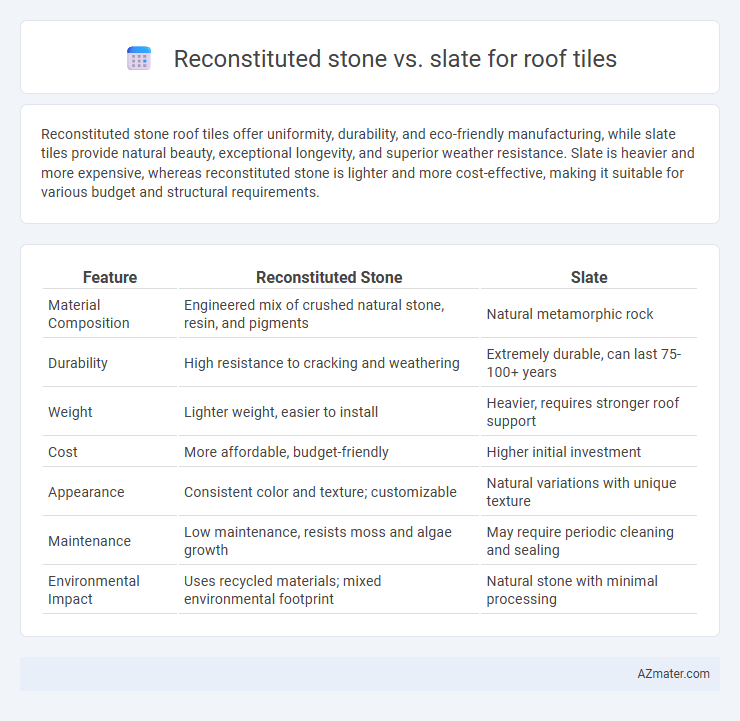Reconstituted stone roof tiles offer uniformity, durability, and eco-friendly manufacturing, while slate tiles provide natural beauty, exceptional longevity, and superior weather resistance. Slate is heavier and more expensive, whereas reconstituted stone is lighter and more cost-effective, making it suitable for various budget and structural requirements.
Table of Comparison
| Feature | Reconstituted Stone | Slate |
|---|---|---|
| Material Composition | Engineered mix of crushed natural stone, resin, and pigments | Natural metamorphic rock |
| Durability | High resistance to cracking and weathering | Extremely durable, can last 75-100+ years |
| Weight | Lighter weight, easier to install | Heavier, requires stronger roof support |
| Cost | More affordable, budget-friendly | Higher initial investment |
| Appearance | Consistent color and texture; customizable | Natural variations with unique texture |
| Maintenance | Low maintenance, resists moss and algae growth | May require periodic cleaning and sealing |
| Environmental Impact | Uses recycled materials; mixed environmental footprint | Natural stone with minimal processing |
Introduction to Roofing Materials: Reconstituted Stone vs Slate
Reconstituted stone roofing tiles offer a cost-effective, lightweight alternative to natural slate while maintaining similar aesthetic appeal and durability. Slate, a natural metamorphic rock, provides exceptional longevity, weather resistance, and a classic, elegant look favored in historical and high-end roofing projects. Comparing reconstituted stone and slate reveals trade-offs in price, weight, environmental impact, and maintenance requirements crucial for informed roofing material selection.
What is Reconstituted Stone Roof Tile?
Reconstituted stone roof tiles are manufactured by blending crushed natural stone with cement and other binding agents, creating a durable and lightweight roofing material. These tiles offer enhanced resistance to weather and impact compared to traditional slate while mimicking its natural appearance. Their consistent size and uniformity make installation easier and reduce long-term maintenance costs.
Natural Slate Roof Tile: Features and Composition
Natural slate roof tiles consist of fine-grained metamorphic rock primarily composed of quartz, mica, and chlorite, offering exceptional durability and natural cleavage for uniform thickness. These tiles provide excellent weather resistance, fireproof qualities, and minimal water absorption, making them ideal for long-lasting, low-maintenance roofing. Unlike reconstituted stone, natural slate boasts unique color variations and naturally formed textures, enhancing the aesthetic appeal and value of any roofing project.
Aesthetic Comparison: Looks and Visual Appeal
Reconstituted stone roof tiles offer consistency in color and texture, providing a uniform and polished appearance ideal for modern architectural designs. Slate tiles display natural variations in tone and texture, resulting in a unique, timeless aesthetic that enhances traditional and rustic roofing styles. The choice between reconstituted stone and slate depends on whether a sleek, controlled look or a naturally varied, classic charm is desired for the roof's visual appeal.
Durability and Longevity: Which Outlasts the Other?
Reconstituted stone roof tiles offer high durability due to their engineered composition that resists cracking, fading, and weathering over time, often lasting 40-50 years or more with proper maintenance. Slate roof tiles, known for their natural stone properties, boast exceptional longevity, frequently exceeding 75-100 years, and maintain strength under extreme weather conditions. While reconstituted stone provides consistent quality and ease of installation, slate's unparalleled lifespan and natural wear resistance generally result in longer durability for roofing applications.
Weight and Structural Considerations
Reconstituted stone roof tiles typically weigh less than natural slate, reducing overall roof load and easing structural demands on buildings. Slate's higher density and weight require stronger roof framing and support systems, making it essential to assess existing structures for compatibility. Choosing reconstituted stone can offer a balance between aesthetic appeal and weight efficiency, especially important in renovation or retrofit projects.
Installation Process and Ease of Use
Reconstituted stone roof tiles offer a lighter weight compared to natural slate, significantly simplifying the installation process by reducing the need for heavy-duty structural support. Slate tiles require skilled labor due to their brittleness and precise cutting needs, whereas reconstituted stone tiles are easier to handle and cut with standard tools. The ease of use of reconstituted stone tiles often results in faster installation times and lower labor costs compared to traditional slate roofing.
Cost Analysis: Reconstituted Stone vs Slate
Reconstituted stone roofing tiles typically cost 30-50% less than natural slate, offering a cost-effective alternative without sacrificing aesthetic appeal. Slate, known for its durability and longevity, commands a higher upfront price that reflects its natural origin and extended lifespan, often exceeding 75 years. Maintenance and installation costs for reconstituted stone are generally lower, making it a budget-friendly choice for residential roofing projects compared to the premium investment of natural slate tiles.
Environmental Impact and Sustainability
Reconstituted stone roofing tiles offer a sustainable alternative to natural slate by utilizing crushed stone and binding agents, reducing quarrying impacts and conserving natural resources. Slate, while durable and long-lasting, involves significant environmental disruption due to extensive mining and energy-intensive processing. Choosing reconstituted stone promotes lower carbon footprints and resource efficiency, aligning with eco-friendly construction practices.
Making the Right Choice for Your Roof
Choosing between reconstituted stone and slate for roof tiles depends on factors like durability, cost, and aesthetic appeal. Reconstituted stone offers a budget-friendly alternative with consistent color and shape, while natural slate provides unmatched longevity and a traditional, elegant look. Considering climate, maintenance, and architectural style ensures the optimal roofing material selection for lasting performance and value.

Infographic: Reconstituted stone vs Slate for Roof tile
 azmater.com
azmater.com